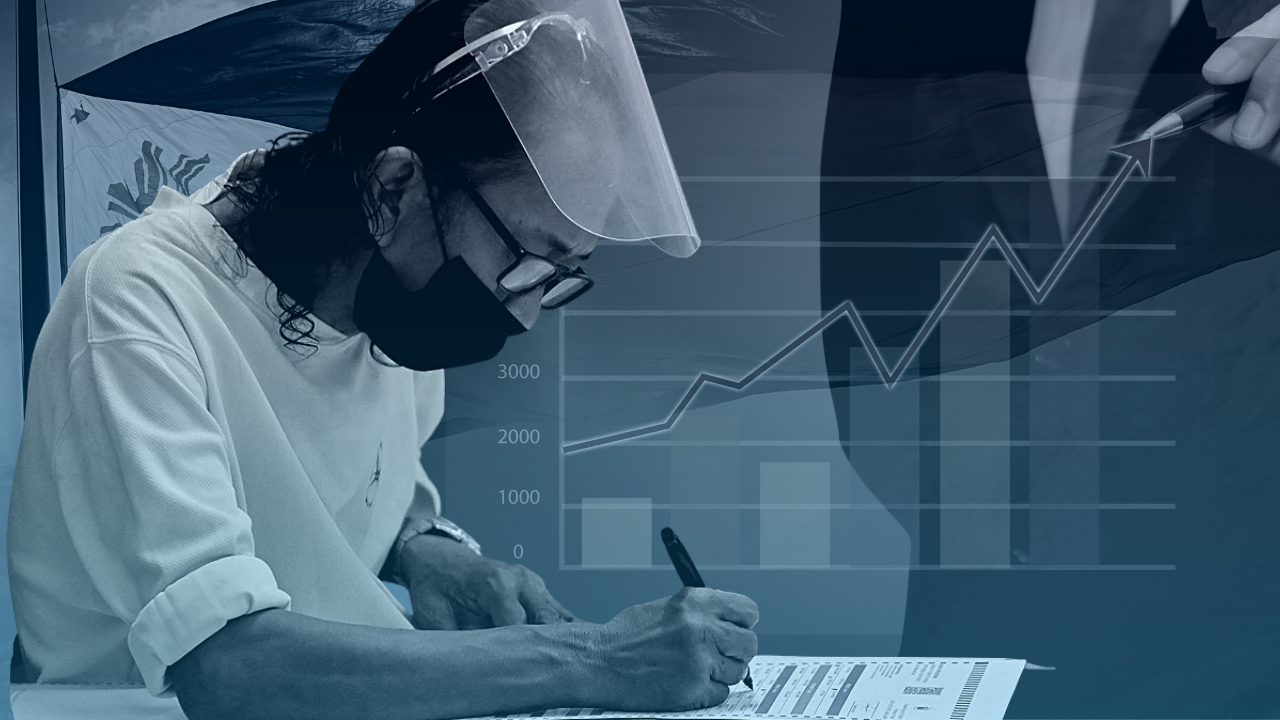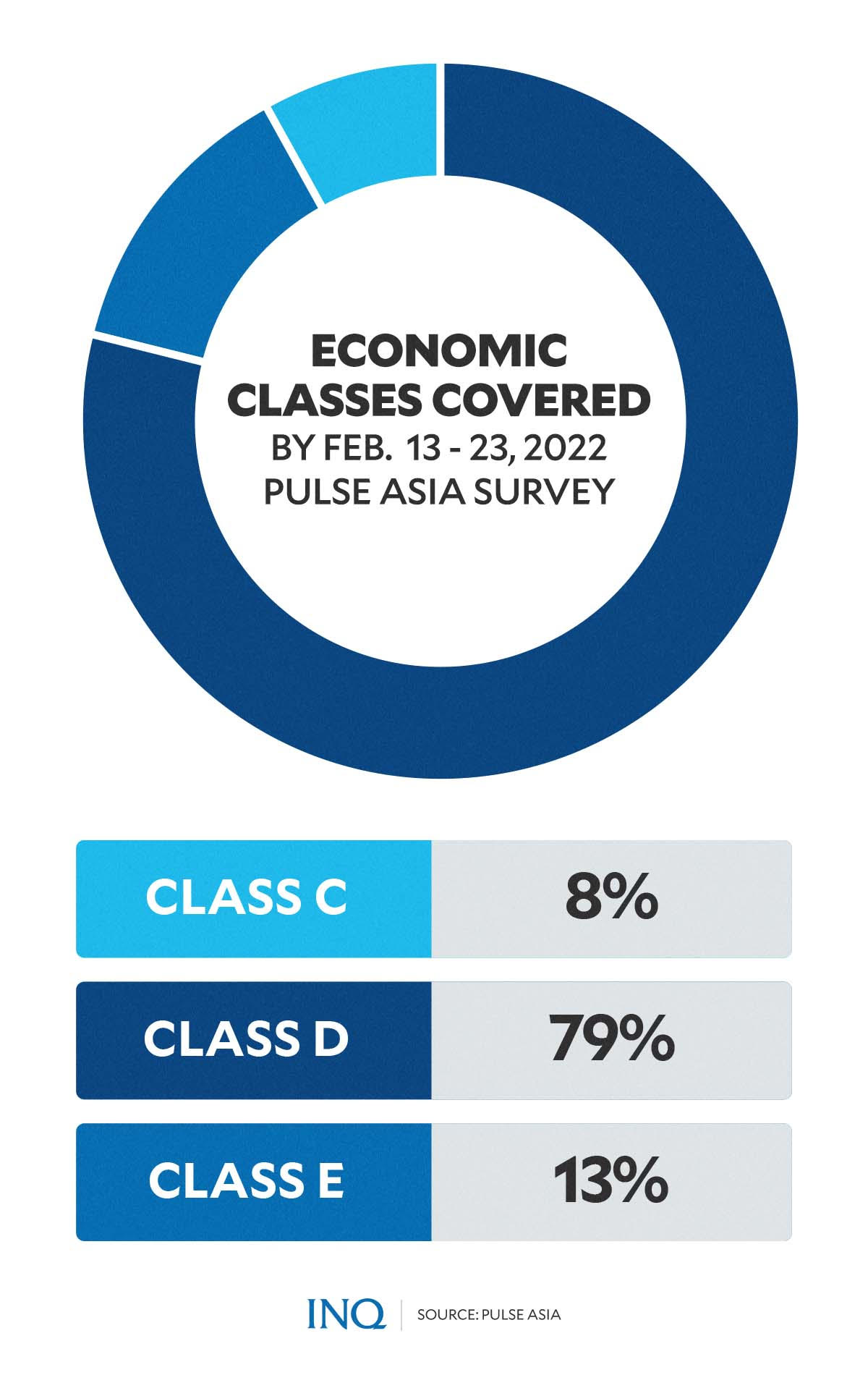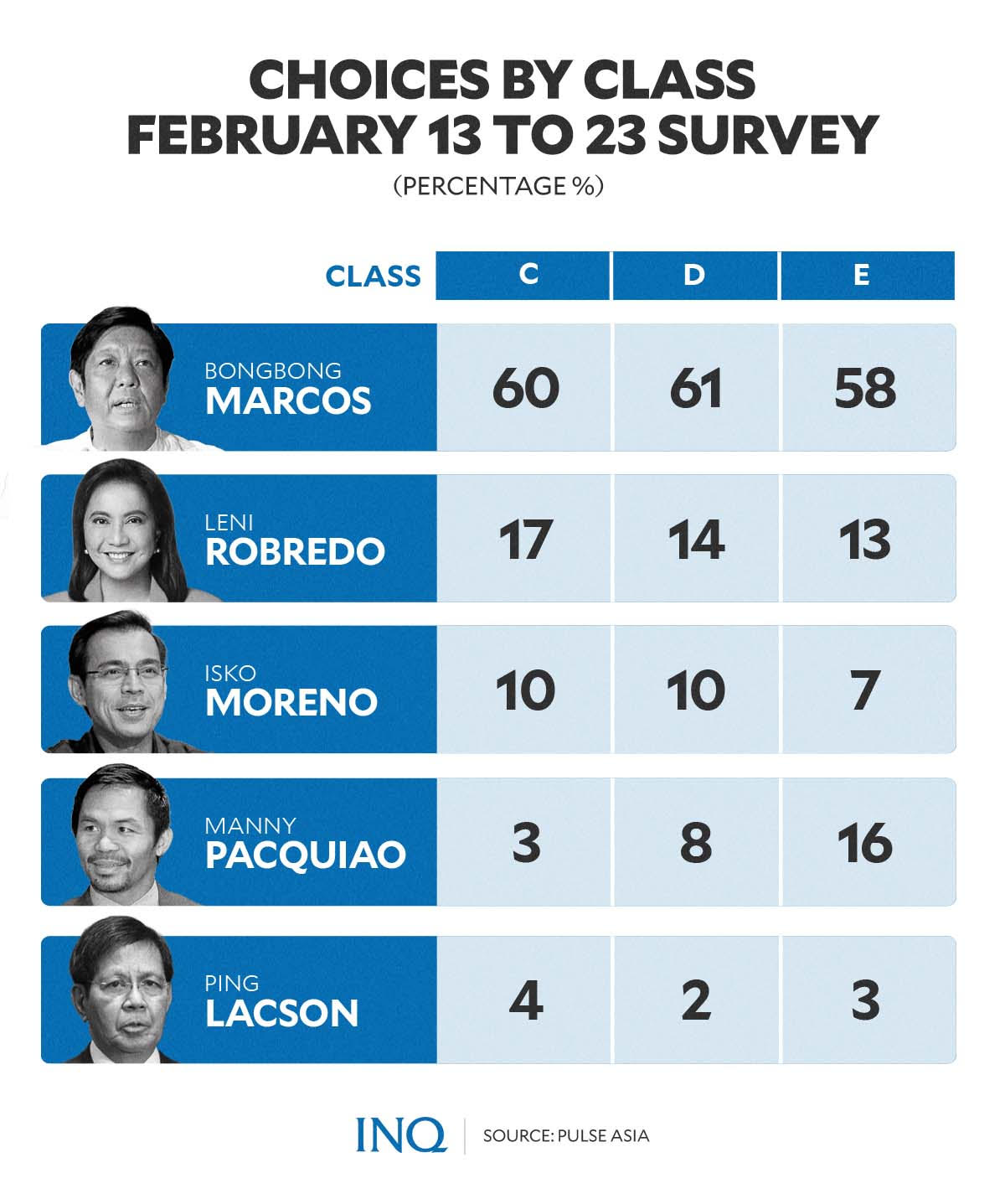Pulse Asia: Without A and B classes, surveys still accurate
MANILA, Philippines—When Pulse Asia released results of its January and February 2022 surveys on voter preference for national candidates, especially for president and vice president, there was one thing missing—the likely choices of the A and B classes of society, or those on the top tier of income levels.
While there’s been no accusation of irregularity in the conduct of the surveys, many people were questioning if results were truly reflective of voters’ most likely choices even if the A and B classes’ opinions were not included.
The survey results, according to Ronald Holmes, Pulse Asia Research Inc. president, mirrored voter sentiment despite the absence of respondents from the A and B classes.
In an interview by phone with INQUIRER.net, Holmes admitted that the A and B classes were not represented in the January and February 2022 surveys which showed Ferdinand Marcos Jr. leading the race for president.
According to Holmes, one possible reason was that the top tiers of the economic grouping were smaller than other classes in terms of proportion of the population—meaning they’re few.
Why Class AB was not included
In previous pre-election surveys on the May 2022 elections, including the December 2021 and June 2021 surveys, Pulse Asia was able to get respondents with different socio-economic classes ranging from class ABC to class D and class E.
Respondents in surveys conducted in 2016, an election year, were also divided according to those three socio-economic groups.
The January and February 2022 surveys, however, did not cover respondents from classes A and B—two of the highest classes.
“In prior surveys when we got respondents who were classified as belonging to Class AB, the combined ABC SEC (socio-economic classes) was 10 to 12% of total adult registered voter population,” Holmes told INQUIRER.net.
“On the other hand, in surveys when randomly selected respondents could only be classified as Class C respondents, they constituted around 8 to 9% of the total adult registered voter population,” he said.
“Based on this, we can estimate that class AB is a minute percentage (around 1 to 4%) of the adult registered voter population,” he explained.
Holmes also clarified that it was also possible that the potential randomly selected respondents belonging to class AB refused to be interviewed or the survey team was not able to get to places—like gated subdivisions—where they can interview random respondents who can be classified as class AB.
In a television interview, Holmes cited as another reason the high refusal rate in face-to-face interviews in areas where class AB respondents can be found.
“This January 19 to 24, there were only about 10 out of 480 sample spots where we had to replace the sample spots, not because of COVID, but because of certain other conditions,” he said in an interview last Feb. 18 over CNN Philippines.
Holmes said Pulse Asia stands by the methodology it uses although some people were claiming irregularities.
“We stand by our record. Our record spans two decades. We have done pre-election surveys since 2000 and our records really show that surveys that are really close to the elections have results that are quite close to the actual election outcome,” he said in an interview on ANC last March 15.
“We are a nonpartisan organization, we follow the same methodologies we’ve applied in the past and these methodologies have served us well in terms of producing valid results or valid data,” Holmes said.
It’s random
He insisted on the randomness of interviews with respondents.
“We do not pre-select respondents based on SEC,” Holmes said, using an acronym for socio-economic classes.
“Or example, a sample spot where there was a particular conflict within the community. [We] randomly select the substitute barangay [or sample spot] for that matter,” Holmes said.
“We classify randomly selected respondents into socio-economic classes (SEC) using various indicators,” Holmes told INQUIRER.net.
Reputable survey organizations worldwide, including Pulse Asia, follow a multistage probability sampling—a systematic technique which, according to Holmes, “secures the heterogeneity of the sample and makes it nationally representative.” Heterogeneity means diverse.
“What we do, based on multistage sampling, is that we randomly select areas where we will get respondents and then subsequently when randomly selected respondents responded to the interview, that’s the time we classify them into socio-economic classes,” said Holmes.
The polling firm uses a program to determine which cities or municipalities will be randomly selected for a specific survey.
The sample size for each randomly selected city or municipality will also depend on the population size of that city or municipality, focusing either on the adult population or the voting population.
A social media post that has been circulating recently claimed that Pulse Asia, in its February 2022 survey, had “no control” over its alleged “outsourced surveyors”—which, according to the post, included some additional questions in the survey.
The post also claimed that the answers to the additional questions by the alleged outsourced surveyors were meant to favor a presidential candidate. The post has been shared many times and fueled questions about survey methods and credibility.
Holmes, in a message sent to INQUIRER.net, first addressed the post and explained that the firm has “full control” of its survey fieldwork.
Full reports of Pulse Asia’s election surveys can be found on its website, Holmes said.
It also publishes documents listing the technical details of surveys or methodology applied to the surveys—including sample size, questions asked, and the crucial events that occurred before or when the survey was conducted—all of which are publicly available, he said.
READ: Survey says: Not all pre-election polls are reliable
Additional question
Holmes admitted that some questions were added to the survey mentioned by the post, but no irregularity was committed.
“As to those questions [that the social media post] claimed were ‘added by outsourced surveyors,’ these were questions that we framed as requested by a subscriber,” Holmes said.
The questions that were added in the latest presidential preference survey by Pulse Asia asked the respondents, “In your opinion, which of the following candidates for the presidency possesses each of the following characteristics mentioned?”
The added question listed characteristics or criteria of an ideal president, including:
- The greatest concern for the poor.
- The most honest and trustworthy.
- The least corrupt.
According to Holmes, the intent of the subscriber, who asked to include the question in the latest survey, “was to really find out the reasons why people are voting for Bongbong,” or Ferdinand Marcos Jr.
He clarified that the respondents were asked first about their presidential preference and the additional question on which presidential candidate best fits the selected criteria came “four or five questions later.”
Responses to the added question showed that most of the respondents chose Marcos as the presidential candidate who has the greatest concern for the poor (47%), the most honest and trustworthy (53%), the least corrupt (41%).
This was despite reports quoting the Bureau of Internal Revenue (BIR) as confirming that there was a collection effort on the Marcoses since they have yet to pay at least P203 billion in taxes on the Marcos estate. The survey results also came amid reports about the alleged ill-gotten wealth that the Marcoses accumulated during the more than 20-year rule of the late dictator Ferdinand Marcos. But it also came amid denials by the Marcos family about possessing stolen wealth.
According to a report by the Presidential Commission on Good Government (PCGG), which has been created to run after ill-gotten wealth allegedly stashed by the Marcoses, the government is still trying to recover more than P125 billion worth of assets that are believed to be part of the Marcos family’s ill-gotten wealth.
READ: Marcos’ martial law: Golden age for corruption, abuses
Holmes said that the “effective rebranding” of the son of the late dictator Ferdinand Marcos might have impacted the answers of survey respondents on the additional question.
Leading now, tailing after
In less than two months before the May 9 elections, the survey said many Filipinos have already made their choices.
Marcos Jr. has maintained his lead over other presidential candidates in the February 2022 survey of Pulse Asia on preferred presidential candidates for the May 9 elections.
According to the survey, 60 percent of the 2,400 adult respondents said they would vote for Marcos if the elections were held during the survey period or on Feb. 18-23.
He had the same rate during the Jan. 19-24 polls, 60 percent―a rate that was considered to be the highest for a presidential candidate in the history of Pulse Asia’s pre-election surveys.
“In Pulse Asia, since we started tracking pre-election preferences for president this is the highest, yes, so from 2004 elections, 2010, and 2016 elections,” Holmes said in an interview with ANC last Feb. 14.
“This is the first time we’re seeing a presidential candidate garner more than 50 percent of the votes,” said Ana Tabunda, Pulse Asia research director, in an interview with ANC last Feb. 15.
At least 15 percent of total respondents nationwide said they would choose Vice President Leni Robredo—who in 2016 defeated Marcos Jr. in the vice presidential race—to be the country’s next chief executive.
The presidential candidates with at least 10 percent likely voters were:
- Manila Mayor Isko Moreno Domagoso: 10 percent
- Sen. Manny “Pacman” Pacquiao: 8 percent
- Sen. Panfilo “Ping” Lacson: 2 percent
- Faisal Mangondato: 0.4 percent
- Labor leader Lady de Guzman: 0.1 percent
- Dr. Jose Montemayor, Jr.: 0.01 percent
Four percent of the respondents were undecided, refused to vote, or will vote for none.
READ: Marcos leads Pulse Asia presidential survey READ: Survey says: Not all pre-election polls are reliable READ: Marcos’ martial law: Golden age for corruption, abuses
Some people questioned the credibility of the additional question inserted in the survey and pointed out that if Marcos had the highest rate for presidential preference, then it is natural that he will also get the highest rate for the question on which candidate has the greatest concern for the poor, most honest and trustworthy, and least corrupt.
Holmes, in response, explained that Marcos gained lower rates for the characteristics or criteria under the said question compared to his 60 percent presidential preference rate.
“I agree to that extent that if a person, for example, selected Bongbong Marcos as the first choice in the presidential race, that person is most likely to say that Bongbong Marcos is the most honest and trustworthy among the candidates,” said Holmes.
“But the other thing that you should notice here, although I have not gone to that data completely, would be the proportion who say that Bongbong is the most honest and trustworthy is not the same as those who signified preference for him,” he added.
“So that only means that some of the people who voted for Bongbong selected some other candidate as more other honest or trustworthy than Bongbong Marcos.”
He also explained that the questions in the latest survey were framed by Pulse Asia itself, including the additional question that was requested by the subscriber.
“I think what we need to understand is that this is a measure of both the reasons why people are voting for a particular candidate and it can also measure the strength or the conviction of the respondent in terms of voting for a particular candidate,” he said.
Shifts in voting disposition, preference
Pre-election surveys are not, in any way, intended to predict the outcome of any election. This means that results of surveys, especially for presidential preference, should not be the basis of predicting who will ultimately win the race on May 9.
For example, in 2016, Sen. Grace Poe—who was then running for president—was the leading candidate in Pulse Asia surveys until the March 1-6 survey.
In Pulse Asia’s last survey conducted on April 26-29, 2016 or a few days before the elections, Davao City Mayor Rodrigo Duterte edged out Poe with a 33 percent preference rate. In second place was Mar Roxas with 22 percent, and Poe in third with 21 percent.
During that same election year, the official tally from the Comelec showed that Davao City Mayor Rodrigo Duterte won the presidential race, with 16,601,997 (39.02 percent) total votes—despite ranking second or fifth in pre-election surveys.
The official Comelec tally for the 2016 presidential race was:
- Duterte, Rodrigo (PDP LABAN): 16,601,997 (39.02%)
- Roxas, Mar (LP): 9,978,175 (23.45%)
- Poe, Grace (IND): 9,100,991 (21.39%)
- Binay, Jejomar (UNA): 5,416,140 (12.73%)
- Defensor Santiago, Miriam (PRP): 1,455,532 (3.42%)
Pulse Asia’s last pre-election survey that year had the exact same sequence or ranking of candidates.
As Election Day draws near, Holmes said that some voters usually firm up their decision on single-winner competitions—such as the presidential race—a few weeks before the elections.
“They would likely change their mind and the change would come about as a result of certain events that would really unmask the candidates that they might be expressing candidates for,” he said.
“There are certain things that would transpire, certain things the candidates would do, events that will impact on the voting support of any of the candidates and those are things that will really affect voting decision,” he added.
The impact of recent events, like the large rallies held by supporters of different presidential candidates, might be captured in succeeding presidential preference surveys.
These kinds of events might or might not cause a significant change in terms of voting support or the presidential preference rates of each candidate.



